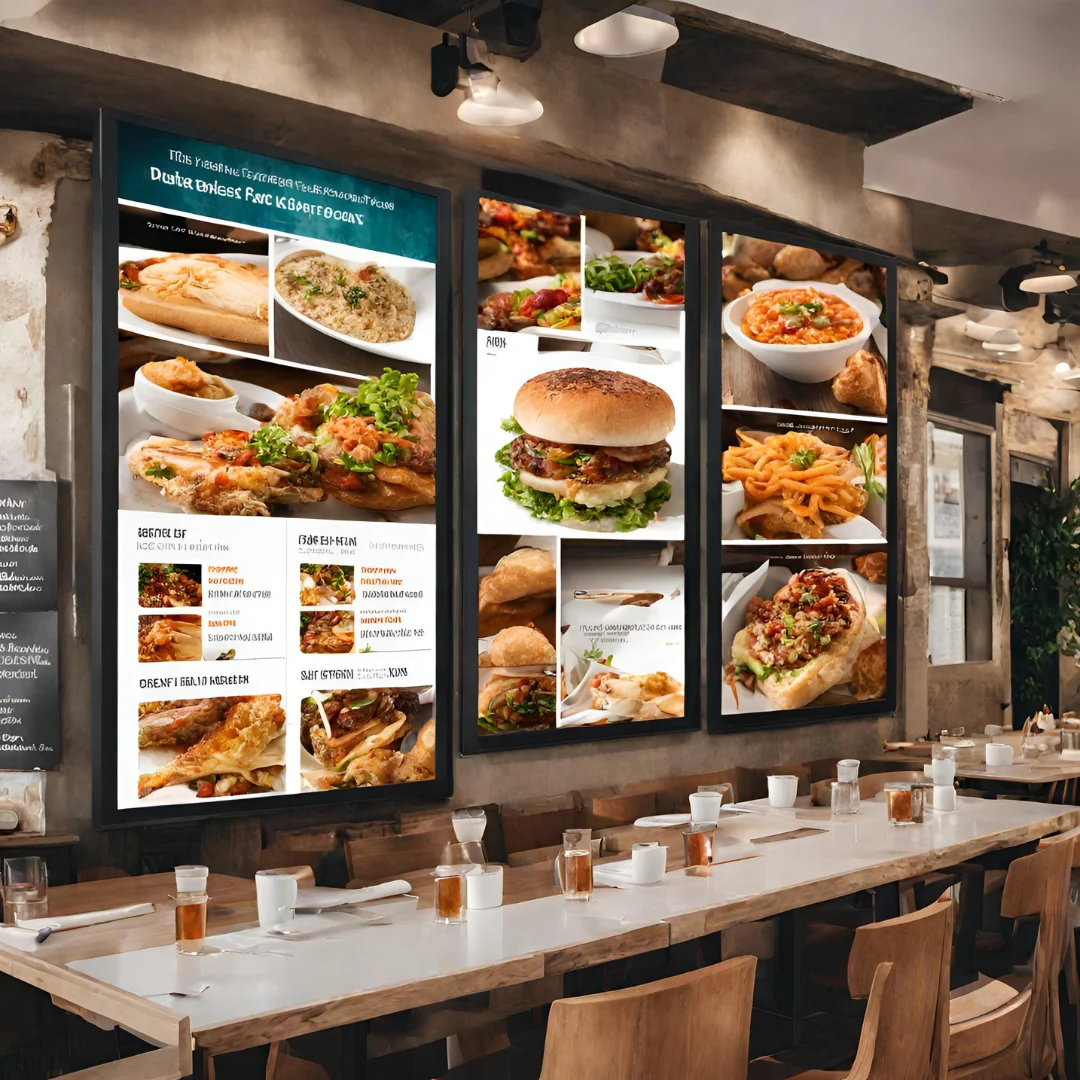In a world where instant engagement is key, the digital displays solution presents an effective means of attracting and educating visitors in any kind of setting. These screens are transforming the way businesses communicate, market, and entertain, from the smooth commercial digital signage displays in retail showrooms to the hardier outdoor digital displays in urban centers.
Introduction to Digital Display Solutions

Consider a scenario where you walk into a hotel lobby and a colorful digital display screen is welcoming you with a personal welcome note, local weather, and highlights of events. Or passing by a shop window in which a digital advertising display device is used to display the new products on motion graphics and real-time pricing. This is the enchantment of contemporary digital display technologies, which makes blank walls become interactive canvases that propel interaction and income.
Evolution from Static to Digital Media
It is not that long ago when companies were using paper posters, vinyl banners, and chalkboards that were manually updated. Every update involved printing expenses, time in installation, and possible delays. With indoor digital displays and outdoor digital displays, today, content changes can occur in seconds through a content management system (CMS), allowing real-time promotions, emergency messages, or live social feeds with no downtime.
Why Businesses Are Embracing Digital Displays
- Dynamic Engagement: Research indicates that digital signs are likely to enlarge customer dwell time up to 400 percent since moving images and selective messages are more attention-getting than fixed signs.
- Operational Agility: If it is a last-minute menu change in a restaurant or an urgent safety announcement in a factory, digital screens do the job by providing the update instantly without the delays of print.
- Long Term Savings: Although the cost of the initial investment may be high, the removal of print and installation costs on a regular basis means that digital signage display monitors are a cost-saving solution in the long term.
- Data Driven Insights: Advanced CMS platforms monitor the content that is performing the best- allowing you to optimize campaigns, place advertisement space, or optimize wayfinding accurately.
Understanding the Core Elements of Digital Display Systems
The full digital display system includes:
- Screen Technology: panels of LED, LCD, or OLED, which should be selected according to the distance of viewing, the presence or absence of ambient light, and the requirements of durability.
- Media player: A minicomputer or device that executes the signage software, usually installed behind the screen to provide a clean installation.
- Mounting & Enclosures: Indoors, VESA mounts, outdoors, weatherproof enclosures, and tamper-resistant casing in public places.
- Software Platform: The core of your system-CM S that manages scheduling, creation of content, remote monitoring, and analytics.
Types of Digital Displays: LED, LCD, OLED
- LED Panels: Suitable in large outdoor applications due to their high brightness (2,0005,000 nits) and energy efficiency. Suitable for stadium, building facades, and transit shelters.
- LCD Screens: Affordable and very popular indoors. Whether in retail settings or corporate conference rooms, LCDs produce crisp 1080p or 4K images at a moderate brightness (300nits-700nits).
- OLED Displays: A high-end display in high-end locations. OLEDs have perfect blacks, ultra-wide viewing angles, and are flexible, ideal for creating an immersive brand environment or digital art installation.
Components of a Commercial Digital Signage Display
A well-built commercial digital signage screen will consist of:
- High Brightness Panels: The ability to be seen in bright places.
- Anti-Glare Coatings: Minimizing the reflections in shopping or hotels.
- 24/7 Rating: Components of commercial grade with constant operation rating.
- Connection: Ethernet or Wi-Fi modules to provide quality content delivery.
- Security Features: Lockable mounts, encrypted software, and user authentication to secure the content.
Applications for Digital Display Solutions Across Industries
Retail Environments
Retailers use digital displays to direct the shoppers, display top-selling merchandise, and allow self-service kiosks, including digital window displays with seasonal promotions, to interactive touch screens in fitting rooms.
Hospitality Tourism Spaces
Digital wayfinding screens are used in lobbies of hotels and resorts, digital advertising display solutions are used in elevators to upsell spa packages, and interactive displays are used in their business centers to display local attractions and events.
Office Spaces and Corporate Spaces
In company lobbies, electronic displays show company news, KPIs, and social media feeds. They have conference rooms, which are equipped with digital whiteboards and remote meeting integration, which enhances productivity and communication.
Medical and Healthcare Facilities
Indoors, digital displays are used in clinics and hospitals to share real-time queue information, health tips, and staff announcements to reduce anxiety and enhance patient flow.
Campus and Education
Colleges incorporate digital signs into the campus news, emergency messages, and wayfinding terminals. Touch screen displays are applied in lecture halls as digital chalkboards.
Chairlifts and Parking Lots
Real-time schedules, safety announcements, advertising, and crowd management in airports, train stations, and event arenas are dependent on digital displays.
Benefits of Digital Display Solutions
Enhanced Customer Engagement
Dynamic content and interactivity prolong dwell time- resulting in more sales in stores and better wayfinding in the city.
Flexibility of Real-Time Content
Cloud-based systems make it possible to update the content in real time, so that messaging remains timely in the event of promotional activities, emergencies, or breaking news.
Time-effectiveness Costs
Save on printing and installation costs by converting to digital signage monitor displays and get ROI in reduced operational costs.
Storytelling and Brand Reinforcement
Digital displays provide the opportunity to create immersive brand stories- integrating video, animation, and data to create an emotional appeal to audiences.
Creative Digital Display Ideas for Impactful Spaces
1. Touch screens that are interactive
Convert retail aisles into self-service centers where consumers can view catalogs, read reviews, and check stock availability.
2. Digital Art Installations
Show generative artwork on OLED displays or video walls that react to time of day, weather, or audience interaction.
3. Branding Displays
Incorporate ambient lighting and moving patterns that support brand identity in the lobbies and hallways, creating another layer of the environment to touch.
Choosing the Best Digital Display Solutions for Your Needs
Assessing Space Requirements and Objectives
Use a foot traffic pattern, sightlines, and viewing distances to find the best screen size and location based on maximum impact.
The Choice of the Screen Size and Resolution
- Small Kiosks (15- 32″): Perfect to be used in interactive menus or directories.
- Medium Screens (43 65”): They are ideal in retail promotions and internal communications.
- Large Video Walls (>75″): Can be used in atriums, stadiums, and outdoor facades.
The Assessment of Digital Signage Software
Put first emphasis on a CMS that does:
- Easy to use Drag and Drop interface
- High-tech Scheduling and Playlists
- Remote Management & Analytics
- Integration with Social Media, News, and IoT
The Future of Digital Display Solutions
AI-Driven Content Personalization
Demographic sensors and on-the-fly content delivery: Screens that recognize demographics and adjust content live and show the right advertisements, languages, or product suggestions based on their user profiles.
Augmented Reality (AR) integration
Digital screens such as AR portals- allowing viewers to use their smartphones to scan the screens, unlocking 3D demos, product previews, or games.
Energy-efficient and Sustainable Displays
Next-gen panels that have solar-assisted power, low-energy backlights, and recyclable materials, which would bring digital signage in line with corporate sustainability objectives.
Ready to Transform Your Environment? Choose Your Digital Display Solution Today!
Digital display solutions are no longer optional extras; they are game-changing tools that change the way spaces talk and interact. With the right choice in screen technology, software, and creative content, companies can create immersive experiences that engage audiences, strengthen brands, and generate quantifiable outcomes.
Frequently Asked Questions (FAQs)
Q1. What is a digital signage monitor display?
A commercial-grade screen that is designed to be used 24/7 and is brighter, more durable, and with network access than consumer TVs.
Q2. Can digital display screens be used outdoors?
Yes– they need a weatherproof enclosure, anti-glare coating, and high high-brightness panel so that they are visible in the sunlight and can be weatherproof.
Q3. How much does a digital signage solution cost?
Prices differ on the basis of screen size, technology, and software features. Indoor systems with entry-level capabilities begin below 1,000, and large, outdoor video walls cost over 50,000.
Q4. How do I manage multiple digital displays remotely?
Make use a cloud-based CMS that allows remote scheduling, content updates, and real-time monitoring through a centralized dashboard.
Q5. What industries benefit most from digital displays?
Retail, hospitality, corporate, healthcare, education, and transportation, basically, any space in which dynamic communication and interaction are appreciated.
Q6. Are interactive touch screens better than static displays?
Interactive screens promote increased participation and enable personal experiences, though even non-interactive digital screens attract more attention and are remembered more than static signage.








